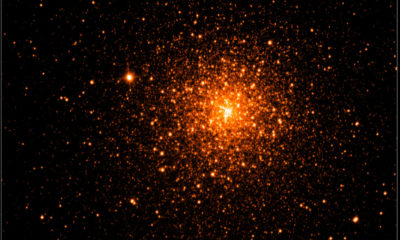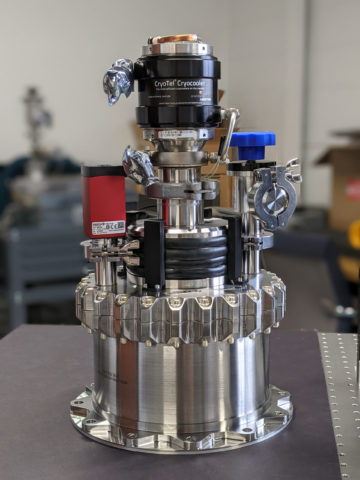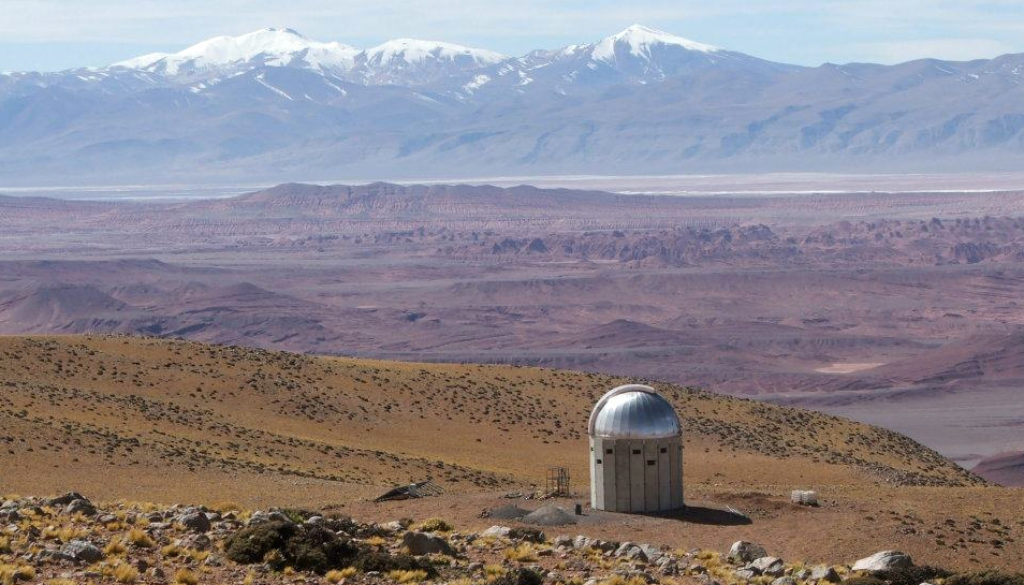Cross-Texas Astronomical Collaboration TOROS Telescope Records First Images
Astronomers from Texas to Argentina recently celebrated a critical milestone in their nearly decade-long project to search for and measure the electromagnetic evidence of gravitational waves throughout the cosmos — “first light” for the Transient Optical Robotic Observatory of the South (TOROS) telescope in northwestern Argentina.
On April 10, a team of engineers and astronomers from the TOROS collaboration that includes The University of Texas Rio Grande Valley, Texas A&M University and the University of Córdoba, recorded the first optical images using TOROS, which is located on Cordón Macón and designed to be operated remotely via the internet. The trio of initial images included Omega Centauri, a globular cluster about 17,000 light years away from Earth; NGC 6752, a globular cluster about 14,000 light years away; and a region within the disk of the Milky Way close to the open cluster NGC 3766, the majority of its stars being about 8,000 light years away.

Despite sub-par conditions on the night the images were taken, Texas A&M astronomer and TOROS co-principal investigator Lucas Macri says their resolution and sensitivity are the equivalent of being able to see two individual Christmas tree light bulbs placed 6 feet apart somewhere in College Station all the way from Brownsville.
The recent observational run that yielded the first-light images marked the first activity at the telescope since the worldwide COVID-19 pandemic effectively halted all on-site progress just as the construction of the observatory’s dome and telescope installation were completed roughly a year ago. The main scientific goal of the project is to follow up on electromagnetic emissions associated with gravitational wave events by “sweeping” large swaths of the southern sky, searching for light flashes associated with the merger of two neutron stars or a neutron star and a black hole.
“This telescope seeks to elucidate some of the research on nuclear physics that we will never be able to recreate on Earth,” said UTRGV astronomer Mario Díaz, who serves as principal investigator for the TOROS project. “The nuclear density in neutron stars and the ‘fireworks’ of incredible energies that ignite in the clash of two of these stellar corpses, who danced together for millions of years progressively approaching the catastrophic final embrace, will allow us to better understand how the stars live and die.”

The observatory’s design sensitivity is expected to be reached by year’s end with the installation of specialized optics and a high-end charge-coupled device (CCD) digital camera, currently being developed and integrated by Texas A&M astronomers Darren DePoy and Jennifer Marshall and their team within Texas A&M’s Charles R. ’62 and Judith G. Munnerlyn Astronomical Instrumentation Laboratory.
“The new camera has a very wide field-of-view and can efficiently search the broad swaths of sky from which the gravitational waves emanate — an important capability, since the existing gravitational wave detectors cannot pinpoint the location of the sources to better than about 100 times the area of the full moon,” DePoy said. “The custom optics and opto-mechanical parts of the camera have been delivered, and we expect to complete construction by the end of the year, with deployment to the remote site in early-2022.”
TOROS is part of the Macon Astronomical Center, a set of facilities erected on the Cordón Macón mountain range in the province of Salta, Argentina. At an elevation of 4,560 meters, TOROS is the highest optical telescope operated by an American institution anywhere in the world. Macri, DePoy and Marshall along with 2016 Texas A&M Department of Physics and Astronomy Ph.D. graduate Ryan Oelkers ’14 were involved nearly a decade ago in scouting and selecting the location, which Marshall notes was a finalist for the billion-dollar European Extremely Large Telescope (E-ELT).
“This site may be one of the best undeveloped sites in the world for astronomy,” Marshall said. “It was tested extensively by the E-ELT project, which ultimately decided to go to a better-known site in Chile, and is now being developed by the Argentinian astronomical community.”
TOROS will continuously sweep the sky to produce reference images while keeping channels open and listening for any alert of a gravitational wave event or similar occurrence, at which point telescope operations will immediately shift to searching for and ideally imaging the event’s optical counterpart. Macri says team members will likely travel to Salta again in the next few weeks to improve the tuning of the telescope and dome, perform additional optical tests and take sequences of images of open clusters.
“The image sequences will give us more information about the photometric accuracy that the telescope will be able to achieve,” Macri said. “Once the state-of-the-art camera and optics are installed and fine-tuned, the project will be close to complete. Our Córdoba partners are also developing software that allows for optimal use of the telescope and the automatic processing of the large amount of images that will be obtained.”
TOROS is funded by the National Science Foundation under a grant to UTRGV and a sub-award to Texas A&M as part of the Windows on the Universe: the Era of Multi-Messenger Astrophysics program. The TOROS project team represents the largest group of gravitational wave researchers in Texas and one of the largest in the United States involved in the LIGO Scientific Collaboration.
“It’s incredibly exciting to see so many years of efforts coming to fruition with these first images from TOROS,” Macri said. “We are looking forward to the installation and operation of the wide-field camera, which will make our project quite competitive in this area of astrophysics. Since TOROS is a telescope that’s fully dedicated to surveying the southern sky from a site with such a high percentage of clear nights, it has the potential to yield a fairly unique dataset that could enable many interesting astro-statistics projects.”
Learn more about TOROS or astronomy at Texas A&M.
# # # # # # # # # #
About Research at Texas A&M University: As one of the world’s leading research institutions, Texas A&M is at the forefront in making significant contributions to scholarship and discovery, including science and technology. Research conducted at Texas A&M generated annual expenditures of more than $1.131 billion in fiscal year 2020. Texas A&M ranked in the top 25 of the most recent National Science Foundation Higher Education Research and Development survey based on expenditures of more than $952 million in fiscal year 2019. Texas A&M’s research creates new knowledge that provides basic, fundamental, and applied contributions resulting in economic benefits to the state, nation, and world. To learn more, visit Research@Texas A&M.
-aTm-
Contact: Shana K. Hutchins, (979) 862-1237 or shutchins@science.tamu.edu or Dr. Lucas Macri, (979) 845-7362 or lmacri@tamu.edu
The post Cross-Texas Astronomical Collaboration TOROS Telescope Records First Images appeared first on Texas A&M College of Science.
